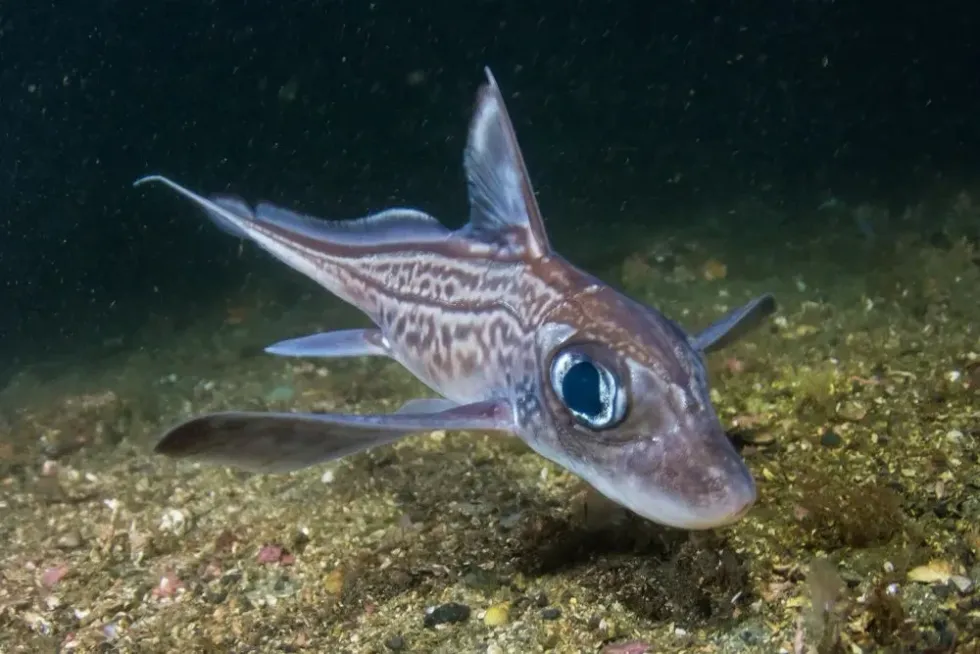Chimaeras are a group of large fishes that are cartilaginous in nature. They are deep sea animals found across the oceans of the world (except the Arctic and Antarctic ocean) and are closely related to sharks and rays.
Some other names by which chimaeras are known are ghost shark, spookfish, rat fish, or rabbit fish. Chimaeras are estimated to have originated nearly 420 million years ago. Classification has led to chimaeras being divided into three families and 52 species.
Chimaeras have a very unique appearance. They have large eyes and a prominent head. Unlike sharks, chimaeras lack sharp teeth.
Instead, they have grinding tooth plates. These tooth plates protrude out of their mouths, giving them a rodent-like appearance.
Hence, the name rabbit fish or rat fish. A chimaera fish is known to prey on worms, crabs, smaller fishes, and so on with the help of their grinding tooth plates. Though the population of chimaeras or ghost sharks is quite spread out geographically, many species are negatively affected due to excessive fishing.
To learn more about deep sea chimaera fish or rat fish, continue reading below! If you like this article, you can also check out hammerhead shark and tarpon.
Chimaera Interesting Facts
What type of animal is a chimaera?
A chimaera is a kind of fish living in the deep water. There are 52 species of chimaera fishes or ghost sharks, which are currently identified.
What class of animal does a chimaera belong to?
Chimaeras belong to the class Chondrichthyes. They belong to the order Chimaeriformes. The various species of chimaeras are divided into three families, namely Callorhinchidae, Chimaeridae, and Rhinochimaeridae.
How many chimaera are there in the world?
Since there are about 52 species of chimaeras, each kind has different trends in population. Some of the species like cape chimaera (Chimaera notafricana) and spotted ratfish (Hydrlagus colliei) have stable and increasing population trends, respectively.
But species like sicklefin chimaera (Neoharriotta pinnata) and silver chimaera (Chimaera phantasma) are decreasing in number, according to the International Union for Conservation of Nature or the IUCN.
Where does a chimaera live?
Chimaeras are found in all oceans across the world, except for the Arctic Ocean and Antarctic Ocean.
What is a chimaera's habitat?
Chimaeras are generally found in temperate waters, meaning the temperature there is mild in nature. Their most common habitat is the deep waters in all the oceans.
Chimaeras can be found in areas under the water with lots of sand and mud or rocks and boulders. They are known to live up to 8,500 ft (2,600 m) below the ocean, or even more. Some species, like the spotted ratfish and rabbitfish are also spotted in shallow water depths.
Who do chimaera live with?
Some species of chimaeras like the Cuban chimaera and elephant fish are known to be solitary and do not display social behavior. However, chimaeras come together during breeding and spawning.
It has also been noticed that they divide into groups based on their age and sex. The ratfish and rabbitfish species are kept in aquariums, so they are capable of co-existing with humans.
How long does a chimaera live?
Chimaeras or ghost sharks are known to be pretty long-living. They can live up to 30 years of age. Their main predators include sharks and humans.
How do they reproduce?
Just like the various species of sharks, chimaeras display internal fertilization. Male chimaeras have some unique structures which help them in mating with female chimaeras.
There is a tenaculum that is club-shaped and located at the upper-part of their head, which they use to hold on to the female during mating. They also have a pair of tenaculae, located in the prepelvic region, which aids in spawning. Once fertilization has occurred, female chimaeras lay two eggs on the floor of the ocean.
Each egg is enclosed in a capsule-like structure. The eggs then continue to develop for 6-12 months before hatching.
What is their conservation status?
Most species of chimaeras are listed as Least Concern (dark ghost shark and spotted ratfish) by the IUCN or International Union for Conservation of Nature. Other species are listed as Vulnerable (silver chimaeras and rabbitfish) or Near Threatened (Mitsukuri's chimaeras and dwarf sicklefin chimaeras).
Their main threat is from humans and fishing activities. Overexploitation of their population for commercial benefits severely affects their numbers. Additionally, they are affected by deep sea trawling, where they end up being caught as bycatch.
Chimaera Fun facts
What do chimaera look like?

The three families of chimaeras are differentiated on the basis of their snouts. The chimaeras belonging to family chimaeridae have a blunt snout.
Those belonging to the family rhinochimaeridae are also known as longnosed fish, due to their pointed snout. Callorhinchidae members are characterized by the presence of a plow shaped nose, and a skin flap protruding from their snout. All chimaeras are known to have a large head with prominent eyes.
Their skin has no scales and appears smooth in nature. There are also two dorsal fins, one of which is toxic in nature to ward off predators. Their large pectoral fins help them in 'flying' through the water.
The tail appears thin and resembles a rat's tail. Usually, chimaeras are brownish-gray, silvery, pale blue, or blackish in color.
How cute are they?
A chimaera, rabbitfish, or ghost shark, does not really appear cute. But these animals provide an interesting insight into the creatures living in deep waters. Additionally, since chimaeras evolved and diverged from sharks and rays a few million years ago, they also provide valuable information in the field of evolutionary biology.
How do they communicate?
There is not a whole lot of research on the ways chimaeras communicate, especially with each other. However, they do have a variety of sensory organs that help them in determining their surroundings and also help in finding potential mates. Like sharks and rays, chimaeras are also capable of sensing electrical impulses.
How big is a chimaera?
Since there are several species of chimaeras or ghost sharks, their length also varies depending on the species. Their observed range of length is between 24-80 in (61-203.2 cm). A great white shark, which belongs to the same class as chimaeras is several times larger.
How fast can a chimaera swim?
Chimaeras use their large pectoral fins to swim underwater. These fins appear broad and like a wing. The animals make a flapping motion with these fins to travel through water. This appears a lot like flying. However, they are considered to be weak swimmers.
How much does a chimaera weigh?
The different kinds of chimaeras or ghost sharks vary in their weight as well. Australian ghost sharks or elephant fishes have a weight in the range of 6.6-8.8 lb (3-4 kg). Rabbitfishes on the other hand can weigh 5.5 lb (2.5 kg).
What are their male and female names of the species?
Male and female fishes belonging to this species are known as male chimaeras and female chimaeras, respectively.
What would you call a baby chimaera?
Baby chimaeras are referred to as hatchlings or juveniles.
What do they eat?
Chimaeras use their special grinding tooth plates to prey on several kinds of animals like marine worms and other fishes. With the help of their grinding tooth plates, they are also capable of feeding on harder creatures like crabs, echinoderms, and clams.
Are they dangerous?
Chimaeras can be considered to be dangerous to humans. Most of the species have a venomous spine, which can cause injury to humans.
Would they make a good pet?
Chimaeras are not really known to be kept as pets. Since these animals belong to the deep seas, their requirements are not like that of regular fishes. However, some chimaeras like the rabbitfish and spotted ratfish are seen in shallow depths as well. Hence, they are kept on display in public aquariums.
Did you know...
In Greek mythology, 'Chimera' was described as a fearsome hybrid creature. This creature was a combination of a lion in the front, a goat in the middle, and a dragon in the end. The term chimaera has originated from this word. Since chimaeras are related to sharks, they are also known as chimera sharks or chimaera sharks.
The earliest remains of chimaeras belong to the early Jurassic period. However, remains of their egg cases have been found belonging to the late Triassic period, which precedes the Jurassic age.
The large elephant fishes have a unique trunk located at the tip of their snout with which they can detect movements and hence, locate their prey.
Do people eat chimaera?
Some chimaera species like the elephant fishes or Australian ghost sharks are edible and eaten by humans. They are caught and sold as 'whitefish' in local markets in Australia and New Zealand. Some areas also sell ratfish and rabbitfish for consumption.
Adaptations to living at depth
Extensive data is not available to ascertain all the adaptations that make chimaeras fit to live in such great depths of water. However, recent studies have shown that chimaeras have low-density oils in their liver, which help them in maintaining buoyancy at such depths.
These animals also have a system known as lateral line canals, which are present on their head and face. The sensory cells in these lateral line canals help them in detecting movement in the water, thus helping them to locate their prey.
Here at Kidadl, we have carefully created lots of interesting family-friendly animal facts for everyone to discover! Learn more about some other fish including codfish, or goblin shark.
You can even occupy yourself at home by drawing one on our chimaera coloring pages.










